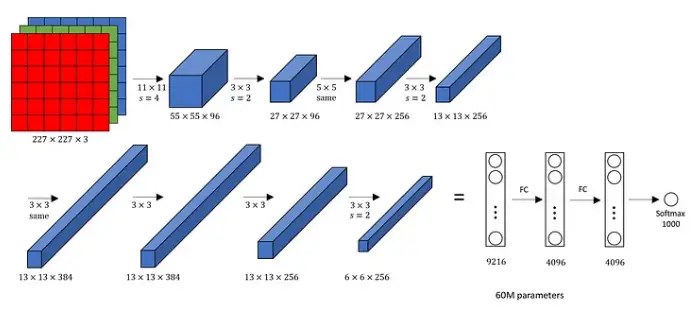The Comparison of CNN Architectures: AlexNet, VGG, and ResNet
Convolutional Neural Networks (CNNs) have revolutionized the field of computer vision, enabling machines to understand and interpret visual data. Among the various CNN architectures, three popular ones are AlexNet, VGG, and ResNet. In this article, we will compare these architectures and explore their applications.
AlexNet
AlexNet, developed by Alex Krizhevsky, Ilya Sutskever, and Geoffrey Hinton, marked a significant breakthrough in the field of deep learning. It won the ImageNet Large Scale Visual Recognition Challenge (ILSVRC) in 2012, outperforming traditional computer vision techniques by a large margin.
AlexNet consists of eight layers, including five convolutional layers and three fully connected layers. It introduced several key concepts that are now commonly used in CNN architectures, such as rectified linear units (ReLU) as activation functions and dropout regularization.

Applications of AlexNet include:
- Image classification: AlexNet can accurately classify images into various categories, making it useful in tasks such as object recognition.
- Object detection: By utilizing region proposal methods, AlexNet can identify and localize objects within an image.
- Image segmentation: AlexNet can separate an image into different regions, enabling more granular analysis of visual data.
VGG
VGG, short for Visual Geometry Group, is another influential CNN architecture. It was developed by the Visual Geometry Group at the University of Oxford and achieved outstanding performance in the ILSVRC 2014 competition.
VGG is known for its simplicity and uniformity. It consists of 16 or 19 layers, with all convolutional layers having a 3×3 filter size and a stride of 1. The network architecture is characterized by its deep structure, which allows it to capture more complex features.
Applications of VGG include:
- Image recognition: VGG can accurately recognize and classify objects in images, making it useful in applications such as image search and content-based image retrieval.
- Artistic style transfer: By utilizing the deep representation learned by VGG, artistic style transfer algorithms can transform images into different artistic styles.
- Medical image analysis: VGG can be applied to medical imaging tasks, such as tumor detection and classification.
ResNet
ResNet, short for Residual Network, introduced a groundbreaking architecture that addressed the problem of vanishing gradients in deep neural networks. It won the ILSVRC 2015 competition and has since become a widely adopted CNN architecture.
ResNet utilizes residual connections, which allow information to flow directly from one layer to another. This helps alleviate the degradation problem that occurs when adding more layers to a network. ResNet can have hundreds or even thousands of layers while still maintaining good performance.
Applications of ResNet include:
- Image recognition: ResNet can accurately classify images, even with a large number of classes. It has been used in various image recognition competitions and benchmarks.
- Object localization: By utilizing its deep structure, ResNet can accurately localize objects within an image, making it useful in tasks such as object detection and tracking.
- Image super-resolution: ResNet can enhance the resolution of low-resolution images, improving the visual quality and details.
FAQs about CNN Architectures: AlexNet, VGG, and ResNet
Q: Which architecture is the best for image classification?
A: All three architectures, AlexNet, VGG, and ResNet, have achieved excellent performance in image classification tasks. The choice depends on factors such as the available computational resources and the specific requirements of the application.
Q: Can these architectures be used for transfer learning?
A: Yes, all three architectures are commonly used for transfer learning. By leveraging the pre-trained models on large-scale datasets, such as ImageNet, users can adapt these architectures to new tasks with limited labeled data.
Q: Are these architectures suitable for real-time applications?
A: While AlexNet and VGG can be computationally expensive, especially on resource-constrained devices, ResNet has shown better efficiency due to its residual connections. However, the choice of architecture for real-time applications depends on the specific requirements and available resources.
Q: Can these architectures be used for natural language processing (NLP) tasks?
A: While CNN architectures are primarily designed for computer vision tasks, they can also be used for certain NLP tasks, such as text classification and sentiment analysis. However, for more complex NLP tasks, architectures specifically designed for NLP, such as recurrent neural networks (RNNs) and transformers, are often more suitable.
Q: Are there any newer architectures that have surpassed AlexNet, VGG, and ResNet?
A: Since the introduction of AlexNet, VGG, and ResNet, several newer architectures have been developed, such as Inception, DenseNet, and EfficientNet. These architectures have achieved even better performance on various computer vision tasks. However, AlexNet, VGG, and ResNet remain influential and widely used in the field.

